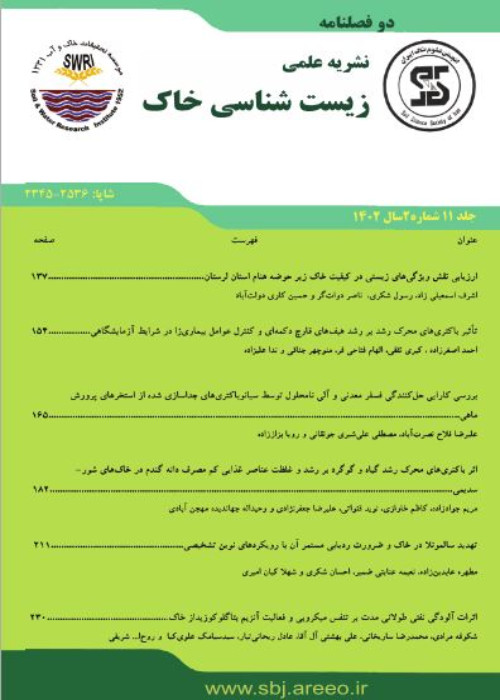Effect of wildfire on organic carbon fractions in the pasture soils of Alvand hillslope
Author(s):
Article Type:
Research/Original Article (دارای رتبه معتبر)
Abstract:
The aim of this study was to recognize the transformation of soil organic matter fractions in burned and unburned pasture lands. The study area was a pasture land located in Alvand hillslope (toposequence), near the village of Haidara, Hamadan. The low-intensity wildfire occurred in the hillslope in autumn (October) 2015, in such a way that half the toposequence was burned up to the bottom symmetrically. Soil samples were gathered from three locations (up, mid, and down) of burned and unburned parts of toposequence 2 (December, 2015-autumn) and 9 months (June, 2016-spring) after wildfire occurrence. In each location, soil sampling was carried out in two parts; between the bushes and under their canopies and in two depths; 0-5 (upper) and 5-10 cm (lower) layers, respectively. Litter samples were also gathered in a 30*30 cm2 plot for each burnt and unburnt parts of toposequence. All sampling was carried out in three replications. The light fraction of organic matter (LF), cold and hot water extractable organic carbons (CWEOC and HWEOC), biomass carbon (BC), total organic carbon (TOC), and basal respiration (BR) were measured. The data analyzed in split-split plot design for each layer (upper and lower) and each season (autumn and spring) of sampling separately. In the mentioned statistical design, sampling location on toposequence (up, mid, and down) was regarded as the main plot, fire impacted area (burnt and unburnt) as a subplot, and sampling location related to bushes (between and under canopy) as sub-sub plot. Soil OC and BR were higher in the upper layer and under the bush's canopy rather than the lower layer and between bushes. In general wildfire increased TOC (42%), LF (41%), and BC (52%) in the sampled soils. In contrast, CWEOC, HWEOC, and BR in burnt soils were 61, 52, and 48% lower compared to those in unburnt soils, respectively. Although in autumn the litter content was lower on burnt soils compared to those in unburnt soils (50%), in spring it significantly increased on burnt soils. The increases in litter on burnt and unburnt soils were 4.5 and 2 times, respectively. The study showed that wildfire and burning of plant cover by producing biochar on the pastures can improve carbon sequestration in soil.
Keywords:
Language:
Persian
Published:
Journal of Soil Biology, Volume:8 Issue: 2, 2020
Pages:
177 to 195
magiran.com/p2190985
دانلود و مطالعه متن این مقاله با یکی از روشهای زیر امکان پذیر است:
اشتراک شخصی
با عضویت و پرداخت آنلاین حق اشتراک یکساله به مبلغ 1,390,000ريال میتوانید 70 عنوان مطلب دانلود کنید!
اشتراک سازمانی
به کتابخانه دانشگاه یا محل کار خود پیشنهاد کنید تا اشتراک سازمانی این پایگاه را برای دسترسی نامحدود همه کاربران به متن مطالب تهیه نمایند!
توجه!
- حق عضویت دریافتی صرف حمایت از نشریات عضو و نگهداری، تکمیل و توسعه مگیران میشود.
- پرداخت حق اشتراک و دانلود مقالات اجازه بازنشر آن در سایر رسانههای چاپی و دیجیتال را به کاربر نمیدهد.
In order to view content subscription is required
Personal subscription
Subscribe magiran.com for 70 € euros via PayPal and download 70 articles during a year.
Organization subscription
Please contact us to subscribe your university or library for unlimited access!


